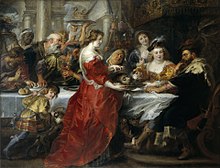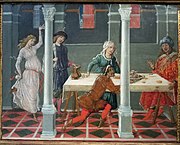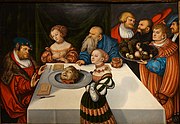|
The Feast of Herod The Feast of Herod refers to the episode in the Gospels following the Beheading of St. John the Baptist, when Salome presents his head to her parents. The account in the Book of Mark describes Herod Antipas holding a banquet on his birthday for his high officials and military commanders, and leading men of Galilee. At this banquet, Herod's daughter dances before Herod, who is pleased and offers her anything she asks for in return. The girl asks her mother what she should request, and she is told to demand the head of John the Baptist. Reluctantly, Herod orders the beheading of John, and John's head is delivered to her, at her request, "on a platter." (Mark 6:17–29) Numerous artistic depictions of the event have been made. Usually the moment shown is the arrival of the head on the platter at the table, carried by Salome. Sometimes the execution itself is shown as a subsidiary scene. The dance of Salome is less often shown before the 19th century; it became more popular after Oscar Wilde's play Salome of 1891, which invented the term Dance of the Seven Veils. In the 16th-century, Salome carrying the head, usually with her maid, became a popular subject, usually called Salome with the Head of John the Baptist, led by Titian's depiction of c. 1515, and with different depictions by Caravaggio in London and in Madrid. Depictions of the main feast include:
Wikimedia Commons has media related to Feast of Herod. |





